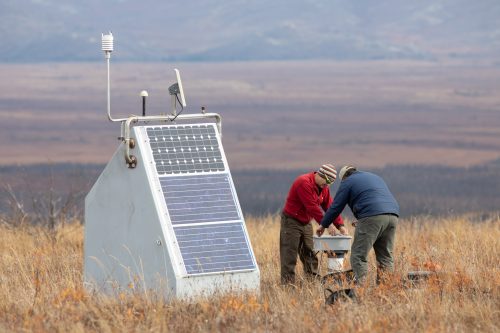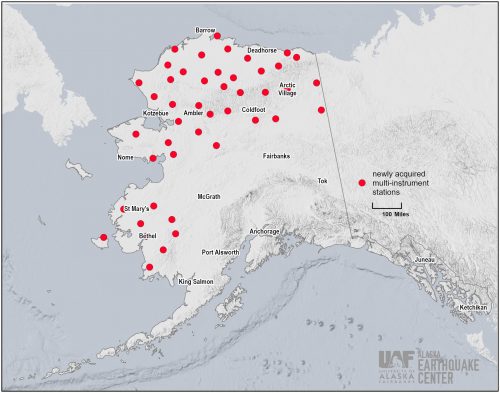Sensors will sustain Alaska earthquake and weather data
November 12, 2020
LJ Evans
907-474-2737

A new project will make it possible for scientists to better track a suite of phenomena in Alaska ranging from earthquakes to wildfires to sea ice.
The five-year, $6.9 million project funded by the National Science Foundation will enhance measurements of Arctic change across western and northern Alaska. It's led by the Alaska Earthquake Center, the Alaska Climate Research Center and investigators from the Geophysical Institute, all part of the University of Alaska Fairbanks.
The project will use real-time observations to help track earthquakes and landslides, detect permafrost changes, monitor sea ice, measure the aurora, forecast wildfire behavior and North Slope weather, and more.
“This project is intended as the seed for a long-term facility, led by UAF, that brings together many agencies and sponsors around the common goal of large-scale, real-time environmental monitoring and observation,” said Michael West, director of the Alaska Earthquake Center and a principal investigator on the project.
The cornerstone of the project is the acquisition of 45 multi-instrument stations. The stations were originally part of the USArray seismic project. The short-term USArray project, installed across Alaska between 2014 and 2017, vastly expanded the amount of seismic data available in Alaska. Instruments for earthquake monitoring were installed for the first time in some remote locations, including sites in northern and western Alaska.
The project was slated to be in place for only a few years, with all stations scheduled for removal in 2020-2021. With this funding, 45 stations will now become part of Alaska’s permanent monitoring network.

“It’s so difficult to establish long-term stations in remote areas, so using these existing installations is very beneficial,” said Martin Stuefer, director of the Alaska Climate Research Center and also a principal investigator for the project.
In addition to seismometers, the 45 stations incorporate instruments for measuring barometric pressure, precipitation, wind speed, relative humidity, temperature, soil temperature and infrasound.
“We have a lot of stakeholders across Alaska asking for answers from the climate center, but we don’t have the data. With the USArray stations, we will,” Stuefer said.
Real-time data from the stations is already benefiting Alaskans. The National Weather Service, Bureau of Land Management and U.S. Geological Survey have taken advantage of the wealth of new information.
The NWS, for example, has used the real-time USArray station data to improve the forecasts needed to operate aircraft safely in the North Slope's rapidly changing weather.
In recent years, wildfires have become more frequent in Alaska, even in Arctic tundra. The BLM has used USArray data to improve wildfire detection and monitoring. The humidity, temperature, pressure and precipitation data collected from each station can help land managers forecast wildfire conditions. Fire response agencies can also better plan where and when to stage firefighting resources.
The overarching goal of the project is to open doors for new research and novel applications that will help Arctic communities and expand our understanding of Arctic change. With the variety of instruments on each station, there are opportunities to foster new, multidisciplinary partnerships.
“This is an exciting project for lots of potential users, from students to researchers to agencies providing community services,” West said. “We hope to establish a resource for long-term data far beyond the next five to six years of the project.”
ADDITIONAL CONTACTS: Michael West, mewest@alaska.edu, 907-474-6977; Martin Stuefer, mstuefer@alaska.edu, (Stuefer will have intermittent email access until Nov. 16)
NOTE TO EDITORS: Download high-resolution maps and photographs at https://earthquake.alaska.edu/new-five-year-multidisciplinary-project-arctic-change.


